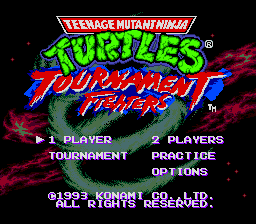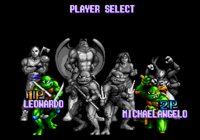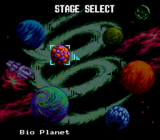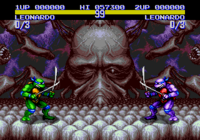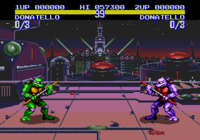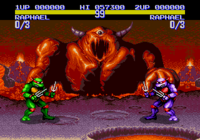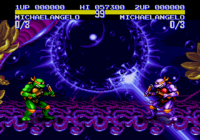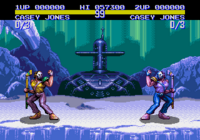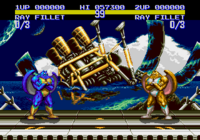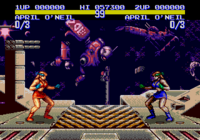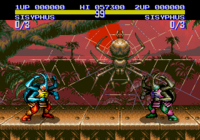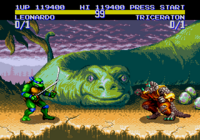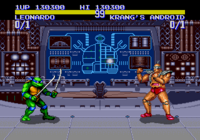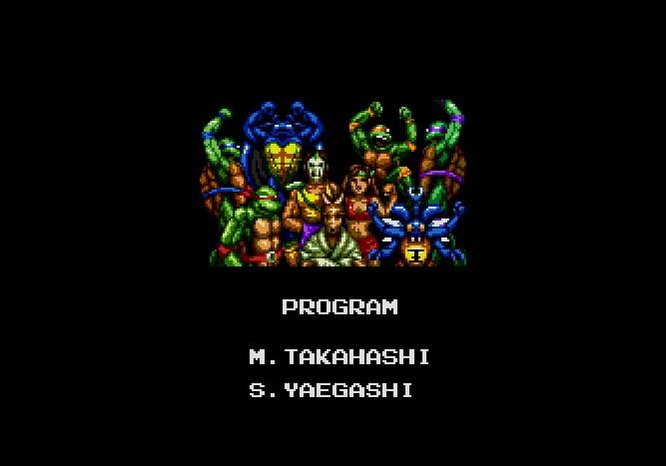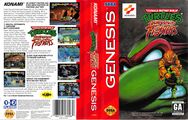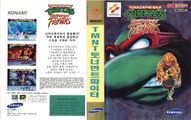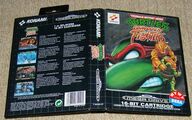Teenage Mutant Ninja Turtles: Tournament Fighters
From Sega Retro
| ||||||||||||||||||||||||||||||||||||||||||||||||||
| Teenage Mutant Ninja Turtles: Tournament Fighters | ||||||||||||||||||||||||||||||||||||||||||||||||||
|---|---|---|---|---|---|---|---|---|---|---|---|---|---|---|---|---|---|---|---|---|---|---|---|---|---|---|---|---|---|---|---|---|---|---|---|---|---|---|---|---|---|---|---|---|---|---|---|---|---|---|
| System(s): Sega Mega Drive | ||||||||||||||||||||||||||||||||||||||||||||||||||
| Publisher: Konami | ||||||||||||||||||||||||||||||||||||||||||||||||||
| Developer: Konami | ||||||||||||||||||||||||||||||||||||||||||||||||||
| Distributor: Samsung (KR) | ||||||||||||||||||||||||||||||||||||||||||||||||||
| Licensor: Mirage Studios, Surge Licensing | ||||||||||||||||||||||||||||||||||||||||||||||||||
| Sound driver: Konami/Lethal Enforcers | ||||||||||||||||||||||||||||||||||||||||||||||||||
| Genre: Action[1][2] | ||||||||||||||||||||||||||||||||||||||||||||||||||
| Number of players: 1-2 | ||||||||||||||||||||||||||||||||||||||||||||||||||
| ||||||||||||||||||||||||||||||||||||||||||||||||||
|
Teenage Mutant Ninja Turtles: Tournament Fighters (T.M.N.T. トーナメントファイターズ), known as Teenage Mutant Hero Turtles: Tournament Fighters in Europe, is a 1993 fighting game developed and published by Konami. It is a fighting game based on the Teenage Mutant Ninja Turtles multimedia franchise, featuring characters from the comics, cartoons, and toy line. It was one of three fighting games released by Konami under the same title, the other two versions being for the NES and Super NES.
Contents
Story
The Teenage Mutant Ninja Turtles and their allies must travel to various planets in Dimension X, fighting clones of themselves, to rescue Master Splinter from the supervillain Krang.
Gameplay
The game is a tournament fighting game in the style of Street Fighter II, featuring characters from the Teenage Mutant Ninja Turtles. Players can choose to play as any of the four Ninja Turtles or their four allies. In each match, two combatants try to knock each other out by draining their opponent's life gauge. The winner of the best of three rounds is wins the match and can move on to the next opponent. Each round has a 99-second timer; if time runs out, the fighter with the most life left wins.
Characters move with ![]() and
and ![]() , crouch with
, crouch with ![]() , and jump with
, and jump with ![]() . The game uses the standard three-button controller, with only two buttons for attacking: punches with
. The game uses the standard three-button controller, with only two buttons for attacking: punches with ![]() and kicks with
and kicks with ![]() . To perform stronger punches or kicks, the player must hold the D-Pad toward the opponent while pressing either attack button (including the lower diagonals for strong attacks while crouching). Characters block attacks by holding in the direction opposite to the opponent. Characters can grab or throw opponents by holding in the direction of the opponent and pressing an attack button while close. Grabs and throws cannot be blocked. Characters can taunt opponents with
. To perform stronger punches or kicks, the player must hold the D-Pad toward the opponent while pressing either attack button (including the lower diagonals for strong attacks while crouching). Characters block attacks by holding in the direction opposite to the opponent. Characters can grab or throw opponents by holding in the direction of the opponent and pressing an attack button while close. Grabs and throws cannot be blocked. Characters can taunt opponents with ![]() . Sometimes characters become dazed after suffering repeated attacks; they become uncontrollable for a short period while stars circle their head.
. Sometimes characters become dazed after suffering repeated attacks; they become uncontrollable for a short period while stars circle their head.
Each character has a selection of unique special moves performed with particular button combinations. Additionally, each character has a special desperation attack that can only be used when they are close to death and the red part of their life gauge is flashing. These moves are especially devastating and can cost as much as half of the opponent's life gauge if successfully landed.
After a match finishes, the game presents an instant replay of the end of the battle.
Modes
The main single-player mode features the turtles and their allies traveling to various planets in Dimension X, fighting against clones of themselves, as they seek to rescue Splinter from Krang. The player can choose the first stage (which corresponds to a particular opponent). After defeating the eight clones, the player travels to the final three stages to fight against a Triceraton, Krang's Android, and Karai.
The game has a two-player versus mode, a practice mode in which the player can pick a computer-controlled opponent to face in one round, and a tournament mode where the player attempts to defeat 88 opponents with a single life gauge.
Players can change the difficulty level of computer opponents (from the easiest at 1 to the hardest at 8), the number of rounds (1, 3, 5, or 7), and the number of credits (3, 5, or 7) as well as toggling the timer in the options prior to starting the game. After selecting a character, players can also change the strength and speed of their characters separately (from the weakest or slowest at 1 to the strongest or fastest at 8).
Characters
Note: Move lists assume that the character is facing right. When facing left, ![]() and
and ![]() should be reversed.
should be reversed.
| ATTACK | Any attack button |
| TAUNT | Taunt |
Special moves can be performed with either attack button (![]() or
or ![]() ).
).
Desperation moves can only be performed when the character's health gauge is low and flashing.
Playable
Bosses
The game has three non-playable boss characters, who only appear in the single-player story mode.
| Triceraton | |
|---|---|
|
Stage: Ancient Planet | |
| Triceraton is an anthropomorphic triceratops. He is a member of an alien race, also called Triceratons. | |
| Krang's Android | |
|
Stage: Technodrome | |
| Krang is an alien warlord and one of the primary antagonists of the Turtles. He uses a robotic body to move and to fight. | |
| Karai | |
|
Stage: Dojo | |
| Karai is the main villain and final boss of the game. At the end of the game, she reveals that she is the one who sent the clone Turtles to kidnap Splinter into Dimension X. |
Stages
Each character has his or her own stage where fights take place in the story and tournament modes. In the versus and practice modes, players can choose any stage for each match.
Some stages contain destructible scenery which grants access to new areas of the stage when destroyed (a feature later seen in Mortal Kombat 3 and its successors).
History
Legacy
The game was included in Teenage Mutant Ninja Turtles: The Cowabunga Collection, a compilation of Teenage Mutant Ninja Turtles games released in late 2022 for the PC, Switch, PlayStation 4, PlayStation 5, and Xbox One. This version has the addition of playable bosses, allowing the player to play as the Triceraton, Krang and his Android, and Karai in any game mode.
Production credits
- Program: M.Takahashi, S.Yaegashi, K.Miyaoka, K.Karasawa
- Graphic Design: Mitsuyo, Duke, K.Suzuki, S.Satoh, N.Takemoto, KTA, NN
- Sound Program: A.Fujio, O.Kasai
- Music: Miki-Chang
- Sound Treatment: M.Adachi
- Package Design: M.Yoshihashi
- Supervisor: Y.Haruki
- Director: Mitsuyo
- Producer: T.Kirita
- Presented by: Konami
Magazine articles
Promotional material
Physical scans
| Sega Retro Average | ||||||||||||||||||||||||||||||||||||||||||||||||||||||||||||||||||||||||||||||||||||||||||||||||||||||||||||||||||||||||||||||||||||||||||||||||||||||||||||||||||||||||||||||||||||||||||||||||||||||||||||
|---|---|---|---|---|---|---|---|---|---|---|---|---|---|---|---|---|---|---|---|---|---|---|---|---|---|---|---|---|---|---|---|---|---|---|---|---|---|---|---|---|---|---|---|---|---|---|---|---|---|---|---|---|---|---|---|---|---|---|---|---|---|---|---|---|---|---|---|---|---|---|---|---|---|---|---|---|---|---|---|---|---|---|---|---|---|---|---|---|---|---|---|---|---|---|---|---|---|---|---|---|---|---|---|---|---|---|---|---|---|---|---|---|---|---|---|---|---|---|---|---|---|---|---|---|---|---|---|---|---|---|---|---|---|---|---|---|---|---|---|---|---|---|---|---|---|---|---|---|---|---|---|---|---|---|---|---|---|---|---|---|---|---|---|---|---|---|---|---|---|---|---|---|---|---|---|---|---|---|---|---|---|---|---|---|---|---|---|---|---|---|---|---|---|---|---|---|---|---|---|---|---|---|---|---|
|
| 72 | |
|---|---|
| Based on 40 reviews | |
| Mega Drive, AS† |
|---|
|
Technical information
References
- ↑ File:TMNTTF MD KR Box.jpg
- ↑ 2.0 2.1 https://sega.jp/history/hard/megadrive/software_l.html (Wayback Machine: 2020-07-02 23:21)
- ↑ Beep! MegaDrive, "October 1993" (JP; 1993-09-08), page 6
- ↑ MAN!AC, "11/93" (DE; 1993-xx-xx), page 57
- ↑ Mega, "January 1994" (UK; 1993-12-16), page 107
- ↑ Sega Force Mega, "December 1993" (UK; 1993-11-16), page 35
- ↑ 7.0 7.1 MegaTech, "December 1993" (UK; 1993-11-20), page 48
- ↑ File:Teenage Mutant Ninja Turtles Tournament Fighters MD credits.pdf
- ↑ 1700 igr dlya Sega, "" (RU; 2001-xx-xx), page 239
- ↑ Aktueller Software Markt, "Februar 1994" (DE; 1994-01-10), page 63
- ↑ Beep! MegaDrive, "December 1993" (JP; 1993-11-08), page 26
- ↑ Consoles +, "Décembre 1993" (FR; 1993-1x-xx), page 162
- ↑ Cool Gamer, "9" (RU; 2002-10-13), page 230
- ↑ Computer & Video Games, "November 1993" (UK; 1993-10-15), page 97
- ↑ Computer + Video Giochi, "Novembre 1993" (IT; 1993-xx-xx), page 68
- ↑ Digitiser (UK) (1994-01-27)
- ↑ Electronic Gaming Monthly, "December 1993" (US; 1993-xx-xx), page 49
- ↑ Entsiklopediya luchshikh igr Sega. Vypusk 1, "" (RU; 1999-xx-xx), page 363
- ↑ Entsiklopediya luchshikh igr Sega. Vypusk 5, "" (RU; 200x-xx-xx), page 245
- ↑ Freak, "1/94" (IL; 1994-xx-xx), page 1
- ↑ Game Players, "Vol. 7 No. 1 January 1994" (US; 199x-xx-xx), page 92
- ↑ Game Power, "Gennaio 1994" (IT; 199x-xx-xx), page 64
- ↑ GamePro, "December 1993" (US; 1993-xx-xx), page 35
- ↑ Game Informer, "January/February 1994 TMNT Pull-out" (US; 199x-xx-xx), page 10
- ↑ Hippon Super, "December 1993" (JP; 1993-11-02), page 43
- ↑ Hyper, "January 1994" (AU; 199x-xx-xx), page 52
- ↑ Joker, "Julij/Avgust 1994" (SI; 1994-xx-xx), page 24
- ↑ Joypad, "Novembre 1993" (FR; 1993-1x-xx), page 100
- ↑ MAN!AC, "11/93" (DE; 1993-xx-xx), page 56
- ↑ Sega Mega Drive Advanced Gaming, "January 1994" (UK; 1993-1x-xx), page 26
- ↑ Mega, "December 1993" (UK; 1993-11-18), page 42
- ↑ Mega Action, "December 1993" (UK; 1993-11-04), page 36
- ↑ Mega Force, "Novembre 1993" (FR; 1993-11-10), page 102
- ↑ Mega Fun, "12/93" (DE; 1993-11-24), page 86
- ↑ Mega Play, "December 1993" (US; 1993-1x-xx), page 75
- ↑ Mean Machines Sega, "December 1993" (UK; 1993-10-xx), page 112
- ↑ Player One, "Décembre 1993" (FR; 1993-1x-xx), page 124
- ↑ Power Unlimited, "Jaargang 2, Nummer 1, Januari 1994" (NL; 1993-12-29), page 26
- ↑ Secret Service, "Grudzień 1996" (PL; 1996-12-01), page 62
- ↑ Sega Power, "December 1993" (UK; 1993-11-xx), page 64
- ↑ Sega Pro, "December 1993" (UK; 1993-11-11), page 66
- ↑ Sega Force Mega, "December 1993" (UK; 1993-11-16), page 34
- ↑ Sega Mega Drive Review, "1" (RU; 1995-04-03), page 166
- ↑ Sega Saturn Magazine, "September 1995" (JP; 1995-08-08), page 87
- ↑ Todo Sega, "Noviembre 1993" (ES; 1993-1x-xx), page 36
- ↑ Tricks 16 bit, "Tricks Sega Gold 800 igr" (RU; 1998-03-20), page 198
- ↑ Video Games, "12/93" (DE; 1993-11-22), page 108
| Teenage Mutant Ninja Turtles: Tournament Fighters | |
|---|---|
|
Main page | Comparisons | Magazine articles | Video coverage | Reception | Promotional material | Region coding | Technical information | Bootlegs | |
| Teenage Mutant Ninja Turtles games for Sega systems | |
|---|---|
| Teenage Mutant Ninja Turtles: The Hyperstone Heist (1992) | Teenage Mutant Ninja Turtles: Tournament Fighters (1993) | |
| Teenage Mutant Ninja Turtles (1991) | |
| Unlicensed Teenage Mutant Ninja Turtles games for Sega systems | |
| Teenage Mutant Ninja Turtles: The Legend Returns (2012) | |
- 1-2 player games
- JP Mega Drive games
- All JP games
- US Mega Drive games
- All US games
- EU Mega Drive games
- All EU games
- DE Mega Drive games
- All DE games
- PT Mega Drive games
- All PT games
- UK Mega Drive games
- All UK games
- AU Mega Drive games
- All AU games
- KR Mega Drive games
- All KR games
- AS Mega Drive games
- All AS games
- Mega Drive games
- 1993 Mega Drive games
- All 1993 games
- Mega Drive action games
- All action games
- All games
- Old-style rating (gamesmaster)
- Rating without PDF source
- Old-style rating (gamesmastertv)
- Update ratings template
- 2 old ratings
- Teenage Mutant Ninja Turtles: Tournament Fighters
- Teenage Mutant Ninja Turtles
